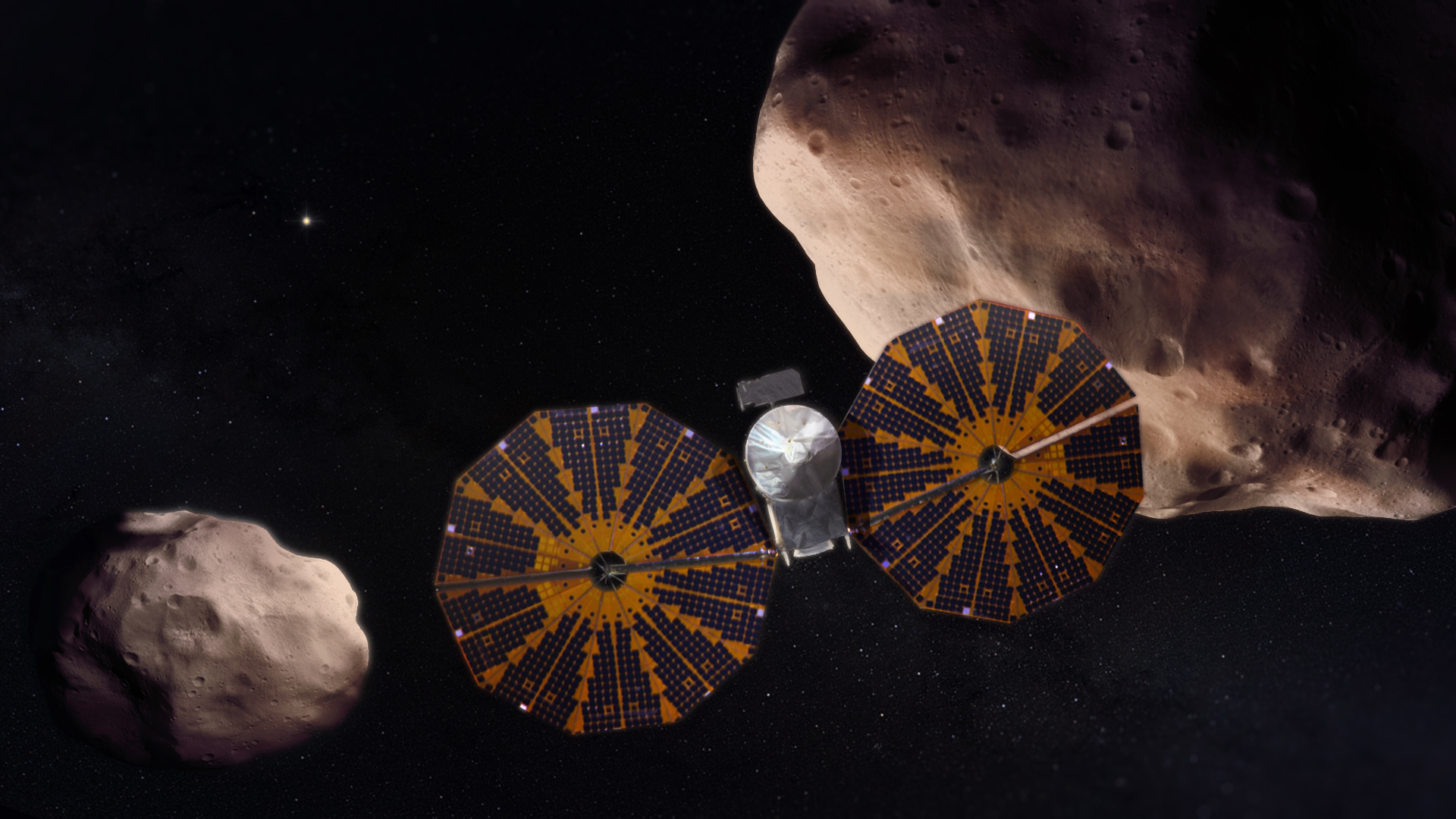NASA's asteroid scout zips past Earth today on 1st launch anniversary
A deep-space mission is celebrating the first anniversary of its launch from Earth by zipping closer to the planet than the International Space Station's orbit.
NASA's Lucy mission launched on Oct. 16, 2021, bound on a 12-year journey to explore the Trojan asteroids, which no spacecraft has ever visited. These asteroids are found at the same distance from the sun as Jupiter, with one phalanx orbiting ahead of the planet and one behind it. All told, Lucy will whiz past nine different asteroids.
But in order to keep those appointments, Lucy first needs to fly past Earth to pick up speed and adjust its trajectory. The first such flyby comes Sunday (Oct. 16) at 7:04 a.m. EDT (1104 GMT); at its closest, Lucy will be just 220 miles (350 kilometers) above Earth's surface, lower than the orbit of the International Space Station, according to a NASA statement. That's close enough that some skywatchers will be able to spot the spacecraft.
"The last time we saw the spacecraft, it was being enclosed in the payload fairing in Florida," Hal Levison, Lucy principal investigator at the Southwest Research Institute in Colorado, said in the statement. "It is exciting that we will be able to stand here in Colorado and see the spacecraft again. And this time Lucy will be in the sky."
Related: Meet the 8 asteroids NASA's Lucy spacecraft will visit

The maneuver might make for thrilling skywatching, but such a close approach is complicated.
First, Lucy must navigate the swarm of satellites orbiting Earth, more than 47,000 in total; according to a NASA statement, the spacecraft must fly through the layer in which the most satellites orbit. To tackle that challenge, mission personnel began assessing potential collisions a week in advance, as early as is helpful.
Get the Space.com Newsletter
Breaking space news, the latest updates on rocket launches, skywatching events and more!
"The further you're predicting into the future, the more uncertain you are about where an object is going to be," Dolan Highsmith, chief engineer for the Conjunction Assessment Risk Analysis group at NASA's Goddard Space Flight Center in Maryland, which evaluates potential collisions for NASA's uncrewed spacecraft, said in a statement.
Mission operators had designed a plan which allowed them to conduct a small engine burn yesterday evening that would move the spacecraft's closest approach by either two or four seconds to prevent a collision.
"That's enough to avoid any one thing that could be in the way," Kevin E. Berry, Lucy's flight dynamics team lead at Goddard, said in the statement.
Satellites aren't the only threat Lucy must navigate; the spacecraft will dip far enough into Earth's atmosphere to begin experiencing drag, especially given the surface area of its two solar arrays, which each span 24 feet (7 meters).
And those arrays are more vulnerable than expected because a glitch in the system that deployed those arrays shortly after launch kept one from fully unfolding, leaving the array resembling a pie with a particularly narrow slice missing. As of NASA's latest update, in June, mission personnel were still considering attempting additional fixes after the flyby. As a protective measure, the mission team arranged for Lucy to pass Earth about 30 miles (50 km) higher than originally planned to reduce the amount of drag the spacecraft experiences.
Although Lucy is flying past Earth out of necessity, scientists are also taking the opportunity to snap a few photos of the moon as the spacecraft heads back into space. The images will help them calibrate the spacecraft's instruments on known terrain before the crucial Trojan flybys.
"I'm especially excited by the final few images that Lucy will take of the moon," John Spencer, acting deputy project scientist at the Southwest Research Institute in Colorado, said in a statement. "Counting craters to understand the collisional history of the Trojan asteroids is key to the science that Lucy will carry out, and this will be the first opportunity to calibrate Lucy's ability to detect craters by comparing it to previous observations of the moon by other space missions."
Once past the moon, Lucy will continue trekking out into deep space, farther from Earth than it's ever been.
Lucy will fly past Earth again in 2024 before trekking out to the Trojan asteroids; a third flyby in 2030 will prepare the spacecraft for its final target, a binary asteroid called Patroclus and Menoetius.
Email Meghan Bartels at mbartels@space.com or follow her on Twitter @meghanbartels. Follow us on Twitter @Spacedotcom and on Facebook.
Join our Space Forums to keep talking space on the latest missions, night sky and more! And if you have a news tip, correction or comment, let us know at: community@space.com.

Meghan is a senior writer at Space.com and has more than five years' experience as a science journalist based in New York City. She joined Space.com in July 2018, with previous writing published in outlets including Newsweek and Audubon. Meghan earned an MA in science journalism from New York University and a BA in classics from Georgetown University, and in her free time she enjoys reading and visiting museums. Follow her on Twitter at @meghanbartels.









